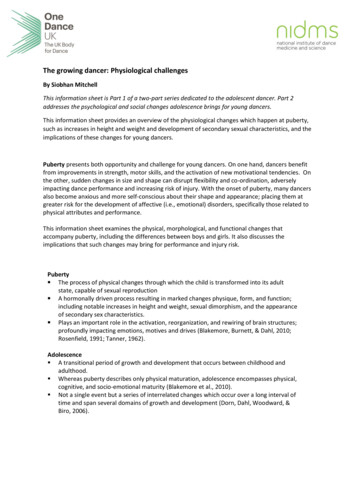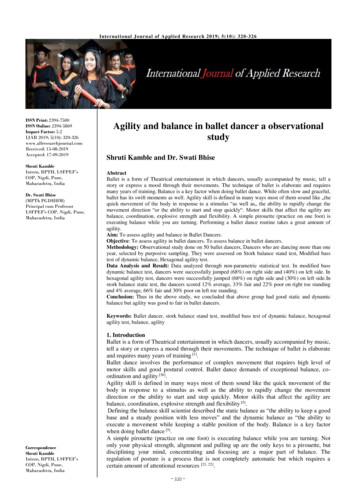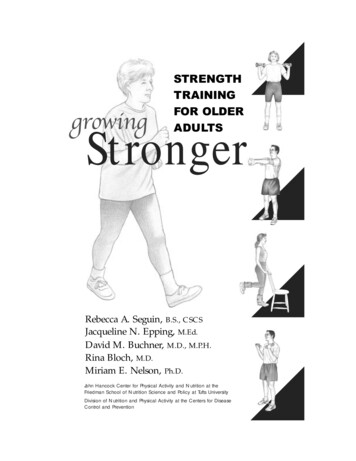
Transcription
The growing dancer: Physiological challengesBy Siobhan MitchellThis information sheet is Part 1 of a two-part series dedicated to the adolescent dancer. Part 2addresses the psychological and social changes adolescence brings for young dancers.This information sheet provides an overview of the physiological changes which happen at puberty,such as increases in height and weight and development of secondary sexual characteristics, and theimplications of these changes for young dancers.Puberty presents both opportunity and challenge for young dancers. On one hand, dancers benefitfrom improvements in strength, motor skills, and the activation of new motivational tendencies. Onthe other, sudden changes in size and shape can disrupt flexibility and co-ordination, adverselyimpacting dance performance and increasing risk of injury. With the onset of puberty, many dancersalso become anxious and more self-conscious about their shape and appearance; placing them atgreater risk for the development of affective (i.e., emotional) disorders, specifically those related tophysical attributes and performance.This information sheet examines the physical, morphological, and functional changes thataccompany puberty, including the differences between boys and girls. It also discusses theimplications that such changes may bring for performance and injury risk.Puberty The process of physical changes through which the child is transformed into its adultstate, capable of sexual reproduction A hormonally driven process resulting in marked changes physique, form, and function;including notable increases in height and weight, sexual dimorphism, and the appearanceof secondary sex characteristics. Plays an important role in the activation, reorganization, and rewiring of brain structures;profoundly impacting emotions, motives and drives (Blakemore, Burnett, & Dahl, 2010;Rosenfield, 1991; Tanner, 1962).Adolescence A transitional period of growth and development that occurs between childhood andadulthood. Whereas puberty describes only physical maturation, adolescence encompasses physical,cognitive, and socio-emotional maturity (Blakemore et al., 2010). Not a single event but a series of interrelated changes which occur over a long interval oftime and span several domains of growth and development (Dorn, Dahl, Woodward, &Biro, 2006).
Biological basis of pubertyEarly adolescenceis characterised by physical changes to the bodyAge 7 - 10resulting from the onset of puberty, these changes have a biological basis.Puberty, itself, involves three distinct hormonal events, namely: Adrenarche Gonadarche Activation of the growth axis (starting the growth spurt)The timing of these events is illustrated in Figure 1; highlighting thegender differences in the onset of each event, and the specific pubertalevents and physical changes which are initiated (Blakemore et al., 2010;Petersen & Taylor, 1980).Developing a greater awareness of when thesehormonal events are likely to occur can enable danceeducators to better understand the biological andphysical development of their students and to considerthis within training and evaluation.Figure 1. Hormonal events at pubertyPhysical changesMany physical changes take place during puberty: Increase in height and weight Changes in the accumulation and distribution of body fat and lean mass Development of a variety of secondary sexual characteristics (e.g. breast development) Shifts in body proportions.The sequence of these changesvaries significantly between boysand girls. Similarly to the timing ofbiological changes, a greaterunderstanding of the sequence ofspecific physical changes can helpto inform training practices withadolescent dancers.Diagrams of the sequence of eventsat puberty show the averages forboys (Figure 2) and girls (Figure 3) inrelation to age. The figuresalongside indicate the range of ageswithin which some of the changestake place and the numbers (below)refer to the stage of development.Figure 2. Average sequence of events for boys atpuberty in relation to age.
Girls tend to mature around 2 years in advance of boys and so will experience physical changes at anearlier age. The growth spurt is likely to have the most significant implications for training and performance. Forexample, during and after the most rapid periods of growth, increased risk of injury, reducedflexibility, co-ordination and balance are likely. For young female dancers, age of menarche often begins in delay of general population norms, withan average age of 13.1 – 13.9 compared to 12.4 – 12.8 (Burckhardt, Wynn, Krieg, Bagutti, & Faouzi,2011; Hamilton, Hamilton, Warren, Keller, & Molnar, 1997; Steinberg et al., 2008). Many people believe that engagement in professional dance training results in delayed maturation.While participation in any activity that results in a negative energy balance (i.e., less energy in thanexpended) can inhibit growth and maturation, there is limited evidence to suggest that dance, per se,is a cause of delayed maturity. Rather, it appears that dance, as an activity, selects for thoseindividuals who possess the most ideal (functional and aesthetic) physiques. As late developingfemales tend to possess more linear physiques (i.e., lower body mass, higher ratio of lean mass to fatmass), it is not surprising that these individuals are more proportionally represented in dance.Figure 3. Average sequence of events for girls at puberty inrelation to age.
An awareness of when the growth spurt is likely to happen for your students and anunderstanding of the additional challenge and increased injury risk associated with adapting tothese changes, during the ‘relearning period’ (Bowerman et al, 2015) will enable realisticexpectations of progress during this period and will also enable you to adapt trainingaccordingly. More visible changes, such as breast development for girls, are important to consider in terms ofadjustment to new physical proportions and the potential for increased self-consciousness.These physical changes at puberty significantly alter a young dancers’ body and in turn, haveimplications for performance, technical ability and injury risk. A key event for young dancers is thegrowth spurt resulting from activation of the growth axis (for a description of the adolescent growthspurt, see Daniels, Rist, & Rijven, 2001). Though individuals of the same chronological age may varyby up to several years in terms of their biological maturation (chronological age is not a goodindicator of physical development at puberty), the average time for this growth spurt to take placeamong non-dancers is around age 12 in girls and age 14 in boys and takes on average around 3 yearsfrom beginning to completion (Malina, Bouchard & Bar-Or., 2004). This age is especially significant asit coincides with a time when most dancers commence more serious training, a greater number ofhours of training each week, and take on new physical challenges in training e.g. many young balletdancers begin pointe work at this age.Implications for performanceMost changes to physical performance are attributed to the timing of growth spurts and/oranatomical and functional changes in the joints which occur during adolescence (Malina, Bouchard,& Bar-Or, 2004). Basic physical changes such as increases in height, body fat and muscle mass have atemporary but significant effect upon physical performance in a number of ways:Figure 4. Implications of growth upon physical performance and capacity
Gender DifferencesGender differences are also important to consider. Girls mature, on average, around 2 years in advance of boys.*Sex differences are notable in both strength and motor performance.Gender differences in these physical parameters become noticeable around age 14 and may beincreasingly challenging for young dancers as these physical factors are key to maintaining andimproving dance technique and performance.In girls strength and motor performance (i.e. the ability to perform physical skills) have been shownto peak during adolescence and even to decline, while the opposite can be seen in males wherestrength and motor performance tend to increase throughout adolescence (Espenschade, 1940;Jones, 1938, 1949; Malina et al., 2004). For male dancers these changes will be advantageous,enabling greater power and strength for grand allegro movements and could be emphasised duringthis period. While for female dancers, some will be at their peak strength and motor performancebenefitting their dance performance, and for others who experience reduced strength and motorperformance, encouragement may be needed to develop these aspects.Sex differences in relation to physical performance can be attributed to greater relative fatness ingirls and greater leanness in boys, which exert opposite effects on performance. The former has anegative effect on most motor performance tasks and the latter has a positive effect, attributed toincrease in size and muscle tissue (Thomas & French, 1985). For both male and female dancers,overall there is likely to be a decrease in technical skill and control, decreased coordination andbalance and changes to alignment necessitated by increased limb length relative to the spine whichwill be challenging for a young dancer to adapt to (Bowerman, Whatman, Harris, & Bradshaw, 2015;Daniels, Rist, & Rijven, 2001).Flexibility is a particularly important component in dance and can be disrupted by growth of thelower extremities and the trunk during growth spurts (Malina et al., 2004). While average flexibilityis reported to increase in girls age 11 - 14 before reaching a plateau, young dancers may not be asflexible as they or their teachers would expect or want for training. It is clear that growth can affectflexibility for young dancers due to the fact that the skeletal system matures in advance of softtissues. Due to the nature of dance movements any loss in flexibility may be especially evident andchallenging to adapt to. These changes will impact upon some of the core dance movements, forexample, reduced strength and flexibility will result in lower leg extensions, reduced balance andcoordination will affect pirouettes and balance positions and as technical control decreases, risk ofinjury increases (Daniels et al., 2001).
Adapting the focus of training during this time can help young dancers both physically andpsychologically. For example, focussing on development of musicality and artistry as well as workingthrough the relearning period on the more technical aspects will help young dancers to feel they are stillprogressing with their training and takes the focus away from the challenges of adjusting to a changingbody which can easily become negative and frustrating. It may be especially helpful to emphasise how movements feel as opposed to how they look during thistime, to reduce training load and adapt exercises for students experiencing their most rapid periods ofgrowth. Flexibility is most responsive to training during childhood and as a dance teacher this is the ideal stageof development in which to promote this attribute. Due to an asynchrony between skeletal and softtissue growth at adolescence, flexibility can be disrupted, during this period the focus can be shifted tomaintaining flexibility rather than promoting it. These changes inevitably lead to young dancers struggling with movements which they are used tobeing able to perform, this can increase risk of physical injury and psychological effects such as loss ofconfidence, reduced motivation and increased self-consciousness. It is important that young dancers understand that these changes, such as reduced flexibility, aretemporary.Implications for injury riskIn addition to these functional and physical changes, there are challenges and increased injury riskassociated with adapting to these changes. During this ‘relearning period’ young dancers mustrelearn technique and re-programme this technique to adjust to new biomechanical challenges, suchas decreased strength, power and flexibility and rapid change in limb length (Bowerman et al., 2015;Phillips, 1999). During this period of rapid growth, susceptibility to injury is increased. Factors suchIncreases inskeletal massfrom anincrease inskeletal size,not increasedvolume anddensityAsynchronybetween rateof growth instature andaccumulationof bone massFigure 5. Skeletal growth and injury riskTemporarystate of lowbone massReducedresistance tomechanicalstress andincreased riskof injuriessuch as stressfractures
as temporary low bone mass and adjustment to new biomechanical challenges can coincide withincreased intensity of dance training.Increases in the mass of the skeleton during puberty are mainly attributed to an increase in skeletalsize, not to increased skeletal volume and density. The asynchrony between the rate of growth instature and accumulation of bone mass reduces the bones’ resistance to mechanical stress andtherefore increases the risk of injuries such as stress fractures in high impact activities such as dance(Bonjour, Theintz, Buchs, Slosman, & Rizzoli, 1991; Bowerman et al., 2015; Fournier, Rizzoli, Slosman,Theintz, & Bonjour, 1997; Theintz et al., 1992). This is most severe at the point of most rapid growth,around age 11 - 12 for females, 13 - 14 for males, and can continue for 3 to 4 years. This coincideswith increases in the intensity of dance training, leaving young dancers at high risk of overuseinjuries (Bowerman et al., 2015; Fournier et al., 1997).Young dancers’ growth rates are also associated with injury risk (Bowerman, Whatman, Harris,Bradshaw, & Karin, 2014). Differences in foot length growth have been found to be associated withsmall to moderate increases in risk of lower extremity overuse injuries in elite adolescent balletdancers. While the sample size in this study was small (N 46) and thus, further research is warrantedto substantiate this risk, the study highlights rate of
Flexibility is most responsive to training during childhood and as a dance teacher this is the ideal stage of development in which to promote this attribute. Due to an asynchrony between skeletal and soft tissue growth at adolescence, flexibility can be disrupted, during this period the focus can be shifted to maintaining flexibility rather than promoting it. These changes inevitably lead to .











